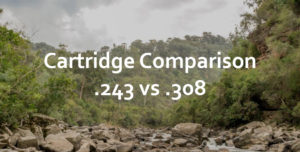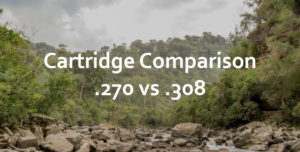People like comparisons and such writing forms always have solid tracking and following. Considering that logic, ammunition cartridges comparisons are quite popular among lovers of the gunpowder smell.
As the cartridges are more similar to each other the debate is raged on hotter as to which of these two rounds is better. But when we are looking for an analogy between the .223 Remington and .308 Winchester, the only connection amid these two would be their military origins and a small overlap in their capabilities.
These two cartridges are post-war designs and represent two vastly different ways of thinking. Both cartridges are results of studies on the experience of the Second World War and the projection of the future modern wars.
Whereas the .223 Remington was designed as a result of changed military thought, the .308 Winchester was based on World War II veteran – .30-06 Springfield. It is because the US military stubbornly insisted on a .30 calibre cartridge which would be the successor of the legendary .30-06.
Comparing the .223 Remington vs .308 Winchester
| .223 Remington | .308 Winchester | |
| Bullet Diameter | .224 in (5,7 mm) | .308” (7.8 mm) |
| Case Length | 1.76 in (45,0 mm) | 2.015” (51.2 mm) |
| Overall Length | 2,26 in (57,0 mm) | 2,800” (71.1 mm) |
| Rim Diameter | .378” (9,60 mm) | 0.478” (12.01 mm) |
| Case Capacity | 28.8 grain H2O (1.87 ml) | 56 gr H2O (3.62 g) |
| Max Pressure (SAAMI) | 55,000 psi (380 MPa) | 62,000 psi (430 MPa) |
| Muzzle Velocity | 3,240 fps (990 m/s) | 2,820 fps (860 m/s) |
| Muzzle Energy | 1,265 ft-lbs (1,715 J) | 2,648 ft-lb (3,590 J) |
| Bullet | 55 gr (4,0 g) | 150 gr (1.9 g) |
| Powder Load | 23.0 gr (1.49 g) | 46.0 gr (2.98 g) |
| Rifle Weight | 7.5 lb. (3.4 kg) | 7,5 lb. (3,4 kg) |
| Free Recoil Energy | 4,0 ft-lbs (0.39 J) | 22,0 ft-lbs (0.72 J) |
The Beginning
Created at the beginning of the 20th century, the .30-06 started out as a military cartridge that was progressively adopted by hunters. Initially, it pushed a 150-grain bullet to 2,700 fps and deliver 1,435 ft.-lbs. of energy on 300 yards target.
With such impressive ballistics, the .30-06 remained the most popular rifle cartridge even after WWII, but in 1952 US Army adopted the scaled-down version of the .30-06, designated as the 7.62x51mm NATO cartridge.
Today the .30-06 Springfield (7.62x63mm NATO designation) still has a wide following among civilian shooters but it also remains service round for venerable machine guns and battle rifles in many military arsenals. Winchester noticed the serious commercial potential of the military round and rolled out the extremely similar .308 Winchester cartridge for the civilian shooting market. Soon, the commercial variant of the 7.62x51mm called the .308 Winchester became a new ballistic benchmark for shooters and hunters and greatly cut into the popularity of the old “ought-six.
Winchester has released to the general public the new .308 Winchester chambered in its Model 70 bolt action rifle and Model 88, a modern lever-action rifle. From that moment, the .308 Winchester became almost an immediate commercial success among hunters and competition shooters all over the world. In short, a rifle chambered in .308 Win could do just about anything needed from hunting to self-defense. In addition, the preppers use this cartridge extensively in short scout type rifles featuring forward-mounted magnified optics with extended eye relief.
.308 Winchester
The .308 Winchester (pronounced: “three-oh-eight” or “three-aught-eight”) is .5-inch shorter than .30-06, 2.015 in vs 2.494 in (51.2mm vs 63.3 mm), making it to fit in more compact actions. This meant lighter and shorter rifles that can shoot flatter, hit hard enough, and recoil a hell of a lot less.
Adopted by the U.S. military in 1952, the originally M80 ball load was topped with a 147-grain full metal jacket (FMJ) bullet. In comparison to .30-06, the .308 Winchester reaches the same muzzle velocity of 2,700 fps while generating 2,469-foot-pounds of energy, a bit less than -06.
In other words, although using a much shorter case (51mm vs 63mm), the .308 Winchester achieved almost the same level of performance due to advances in powder technology.
While it replicates the performance of the .30-06 150-grain load, .308 is actually derived from the .300 Savage cartridge. As one of the best big game hunting cartridges around, the .308 Winchester is not punishing to shoot. In fact, it has a relatively mild recoil making it a good all-around big game hunting cartridge.
With ample power for most species in North America, the .308 cartridge is well suited for home or self-defense, particularly due to the availability of well-designed semi-automatic rifles like the AR-10, the FN FAL, and the Springfield M1A.
Speaking of the main battle rifle, the .308 Win has a short military career, but it remained the standard issue cartridge for the semi-auto long-range sniper rifle and continued to serve as Designated Marksman Rifle as well as machineguns.
While the .308 Win. got a new life in the military, as for a benchrest shooting and other target sports the .308 Winchester is probably not the best choice anymore.
With the same exterior dimensions, the .308 Winchester and the 7.62x51mm NATO are technically different rounds. The practical difference in performance between the .308 vs 7.62 is very small and the most distinctive feature refers to the pressure.
The commercial .308 cartridges are typically loaded to higher pressures, but it is a common belief that firing the commercial round in firearms chambered for the NATO round is not unsafe but we wouldn’t recommend you try this.
.223 Remington
The .223 Remington (pronounced either: “two-two-three” or “two-twenty-three”) is one of the most popular rounds among American shooters today. The .223 Remington is a common rifle cartridge like the .308 Winchester but of a much smaller calibre.
Since the .223 Rem is commonly paired with an AR-15 (M16) rifle, these rifle cartridges have a pretty good supply of surplus military ammo but there are also large amounts of high-quality hunting and target shooting ammunition.
As in the case of the .308 Winchester and 7.62x51mm NATO, the same can be said for the relationship between .223 Remington and 5.56x45mm NATO. Let’s clarify some doubts about these two cartridges variants at the very beginning.
Although these two cartridges come with almost the same external dimensions, there are small differences between the .223 Rem and 5,56 NATO. These variations come down to chamber pressure differences between the .223 Rem vs 5.56 NATO.
A .223 Remington is loaded to approximately 55,000 psi, whereas the 5.56 NATO cartridge runs at the higher pressure level of approximately 58,000 psi. In other words, the .223 ammo tends to be loaded lighter and 5.56 ammunition tends to be loaded hotter.
While you should experience zero issues firing .223 Rem cartridges in your 5.56 NATO rifle, many gun authorities don’t recommend shooting a 5.56 NATO round in a rifle chambered for .223 Rem.
However, the civilian market is predominantly represented with firearms chambered in .223 Rem but if you are a plinker or have piled up a vast stock of 5.56 ammo (theres still a lot of civilian 5.56x45mm brands on the market in places like the US) you can select the rifles with .223 Wylde chambers. This chambering was designed to safely and more efficiently fire both .223 Remington and 5.56×45 NATO.
Let’s back to the .223 Rem origins. After the first field reports from the Vietnam battle zone, US Army started to look for a lightweight rifle that could handle a variation of .22 calibre ammunition. As a result, the .223 Rem was born out of an experimental military cartridge.
The .223 Remington descended from the .222 Remington cartridge as its lengthened version loaded with a 55-grain prototype bullet. Using .222 as a parent cartridge, the new .223 Rem fired a .224″ full metal jacket bullet at 3,250 feet per second generating 1,290-foot-pounds of energy. The original M193 ball load for the 5.56x45mm cartridge has a flatter trajectory than the .308 Winchester out to 500 yards, but the .308 Win load has more than twice the muzzle energy than the initial .223 Remington round.
Over time, the .223 Remington factory offering became much wider with bullets weights in the 35-90 grain range. But most of these lightly constructed bullets are designed for varmint hunting and pest control lacking the stopping power and penetration to take down big game.
While the felt recoil will vary from shooter to shooter, it is a fact that .223 Rem has less than 1/5 the recoil of the relatively mild recoil of .308 Winchester.
Without a doubt, the .223 Remington is now a major selling cartridge, particularly if you want a varmint or target shooting cartridge. Compared to the .308 Win as a medium game cartridge, the .223 is underpowered and moreover, it is prohibited in many countries for hunting medium game due to insufficient killing power.
As for the military 5.56x45mm NATO, this cartridge comes with today prevailing a 62-grain full metal jacket boat-tail bullet, which penetrates much better than the old M193 load. The lead-free M855A1 62 grainer is an enhanced performance round with a copper-jacketed steel core and steel penetrator. The so-called “green ammo” is optimized for the shorter-barrel M4 carbines with a faster 1-in-7 barrel twist rate.
Speaking of barrel life, the 7.62 (.308) would generally outlast a 5.56 (.223). The average .223 barrel should be changed over at around 5,000 rounds and for .308 barrel you can expect 6-8,000 rounds of life.
Related: Read our guide on comparing the differences between the .17HMR vs. .22 Magnum
Final thoughts on the .223 vs .308w
Instead of two, we actually reviewed all of the three major military rifle calibres of the U.S. military in the 20th century – .30-06 Springfield (7.62x63mm NATO), .308 Win (7.62x51mm NATO) and .223 Remington (5.56×45 NATO).
If we disregard a venerable .30-06, there is nothing similar between the other two rounds except the military origins. Both of them are outstanding modern military staples that best suited for radically different tasks.
The .308 Winchester (7.62 NATO) was designed for long-range shooting accuracy, while the .223 Remington (5.45 NATO) was designed to engage targets at close to intermediate ranges in line with modern battlefield concepts.








